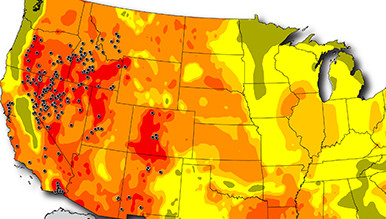The 8th installment of our #GeothermalFactsandStats campaign looks at the geothermal resources of the United States.
ThinkGeoEnergy published a 1 GW Club update that includes, New Zealand, Turkey, Philippines, Indonesia and the United States as exclusive members, with Mexico (951 MW) as the next closest member. The United States leads all 1 GW Club members with 3,591 MW of geothermal power online.
The National Renewable Energy Laboratory’s (NREL) map of potential geothermal resources across the U.S. shows the potential for development of deep enhanced geothermal systems (EGS), as well as identified hydrothermal resources.
The color patterns identify the potential for deep EGS, or technology still to be proved commercially viable to extract energy from dry rocks deep below the surface. It’s impressive to think that we could see the number of MW’s online in the United States double with the continued development of EGS technologies.
The black data points highlight existing hydrothermal resources (naturally occurring shallow hot water reservoirs).
As you can see the heat is largely concentrated in the Western United States. Which explains the development of 3,591 MW by industry leaders, Calpine Corporation in The Geysers, Cal Energy Resources in the Salton Sea (California), Ormat Nevada across Nevada and California and others including Enel Green Power, Energy Source (Hudson Ranch) and a handful of others.
The big picture is that even though the United States is a world leader of Geothermal power online, and there are GW’s of untapped geothermal potential here – other 1 GW Club members have been shown to have even more potential, with more incentive to develop. We won’t be surprised when Indonesia surpassed the United States and when an East Africa country like Kenya joins the 1 GW Club soon.
Stay tuned for more #GeothermalStatsandFacts …and follow us across our social media platforms!
#geothermal #thisisgeothermal #lovegeothermal


